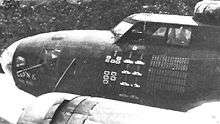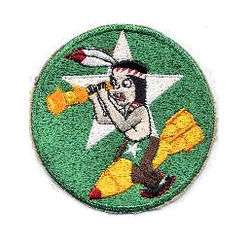64th Bombardment Squadron
| 64th Bombardment Squadron | |
|---|---|
|
Emblem of the 64th Bombardment Squadron | |
| Active | 1940–1970 |
| Country | United States |
| Branch | United States Air Force |
| Role | Bombardment |
| Part of | Strategic Air Command |
| Engagements | World War II |

The 64th Bombardment Squadron is an inactive United States Air Force unit. It was last assigned to the 72d Strategic Wing (Provisional), based at Andersen AFB, Guam. It was inactivated on 15 November 1973.
History
Established in 1940 and activated in 1941 as a bomber squadron, assigned to the GHQ Air Force Northeast Air District. Trained and was equipped with both early model B-17C/D Flying Fortress heavy bombers and B-18 Bolo medium bombers at Langley Field, and flew training missions over the Mid-Atlantic States. After the Pearl Harbor Attack, was deployed to New England and began flying antisubmarine missions from Bangor Airport over the Newfoundland Straits and performing aerial convoy patrols over the North Atlantic shipping lanes.
Deployed to Australia in February 1942, being assigned to the new Fifth Air Force being formed after the withdrawal from the Philippines of remaining heavy bombers. The squadron reached Australia in March 1942, but did not enter combat until September, when it finally had a reasonable complement of aircraft. From then until November 1944, the squadron operated in support of the campaign in Papua New Guinea, first from Australia, then from New Guinea and Owi Island, concentrated in particular in attacks on shipping. The unit experimented with low level skip bombing, using this tactic at the Battle of the Bismarck Sea, 2–4 March 1943 with some success.
Between May and September 1943, the squadron's B-17s were replaced with B-24 Liberators, believed to be more suited to the long ranges of many Pacific missions. In November 1944 the squadron moved to the Philippines, helping the ground campaign on Luzon as well as conducting long range strategic bombing missions against targets in China and Formosa. Finally in July 1945 it moved to Ie Shima, from where it flew missions over Japan, still attacking shipping, as well as airfields and railways until the Japanese Capitulation in August. Squadron demobilized on Okinawa, aircraft being sent to the Philippines for reclamation. Inactivated as a paper unit in April 1946.
Reactivated under Strategic Air Command in late 1946 and equipped with B-29 Superfortresses. One of the first operational B-29 squadrons of SAC, the squadron was not fully manned or equipped until 1948. Trained for strategic bombardment missions during the postwar years, being upgraded to the new atomic bomb-capable B-50 Superfortress in 1948. Replaced the propeller-driven B-50s with new B-47E Stratojet swept-wing medium bombers in 1954, capable of flying at high subsonic speeds and primarily designed for penetrating the airspace of the Soviet Union. In the late 1950s, the B-47 was considered to be reaching obsolescence, and was being phased out of SAC's strategic arsenal. Began sending aircraft to other B-47 wings as replacements in late 1959. Moved to Carswell AFB, Texas in early 1960, in preparation for receiving the new B-58 Hustler supersonic medium bomber, sending the last of its B-47s to AMARC in early 1960.
Received the first B-58s in March, receiving new aircraft throughout 1960. Performed training and became proficient with the new bomber, reaching Operational Ready state in 1962. Trained and participated in many SAC exercises and deployment throughout the 1960s. Phaseout of the B-58 fleet was ordered by Secretary of Defense Robert McNamara in December 1965, since it was felt that the high-altitude performance of the B-58 could no longer guarantee success against increasingly sophisticated Soviet air defenses. Began sending aircraft to AMARC in November 1969, the squadron inactivated in January 1970.
Reactivated in 1972 at Andersen AFB, Guam, as a provisional B-52G Stratofortress squadron due to Andersen going back on alert due to the North Vietnamese Vietnam War 1972 Easter Offensive and the commencement of Operation Linebacker I and later Linebacker II strategic bombing missions in December 1972. Squadron's aircraft flew very long range combat missions over Indochina during 1972, ending combat operations on 15 August 1973 flying the last B-52 raid over Cambodia. Inactivated in November 1973 after combat operations ended over Indochina.
Lineage
- Constituted 64th Bombardment Squadron (Heavy) on 20 November 1940
- Activated on 15 January 1941
- Inactivated on 29 April 1946
- Redesignated 64th Bombardment Squadron (Very Heavy), and activated, on 1 October 1946
- Redesignated 64th Bombardment Squadron (Medium) on 2 July 1948
- Inactivated, 31 January 1970
- Redesignated Bombardment Squadron (Provisional), 64 on 1 June 1972 and placed in provisional status.
- Inactivated and Discontinued on 15 November 1973
Assignments
- 43d Bombardment Group, 15 January 1941 – 29 April 1946
- 43d Bombardment Group, 1 October 1946
- 43d Bombardment Wing, 16 June 1952 – 31 January 1970
- Strategic Wing (Provisional), 72, 1 June 1972 – 15 November 1973
Stations
|
|
Aircraft
- B-18 Bolo, 1941–1942
- B-17 Flying Fortress, 1942–1943
- B-24 Liberator, 1943–1945
- B-29 Superfortress, 1946–1950
- B-50 Superfortress, 1948–1954
- B-47 Stratojet, 1954–1960
- B-58 Hustler, 1960–1970
- B-52 Stratofortress, 1972–1973
See also
References
![]() This article incorporates public domain material from the Air Force Historical Research Agency website http://www.afhra.af.mil/.
This article incorporates public domain material from the Air Force Historical Research Agency website http://www.afhra.af.mil/.
- Maurer, Maurer, ed. (1982) [1969]. Combat Squadrons of the Air Force, World War II (PDF) (reprint ed.). Washington, DC: Office of Air Force History. ISBN 0-405-12194-6. LCCN 70605402. OCLC 72556.


.svg.png)